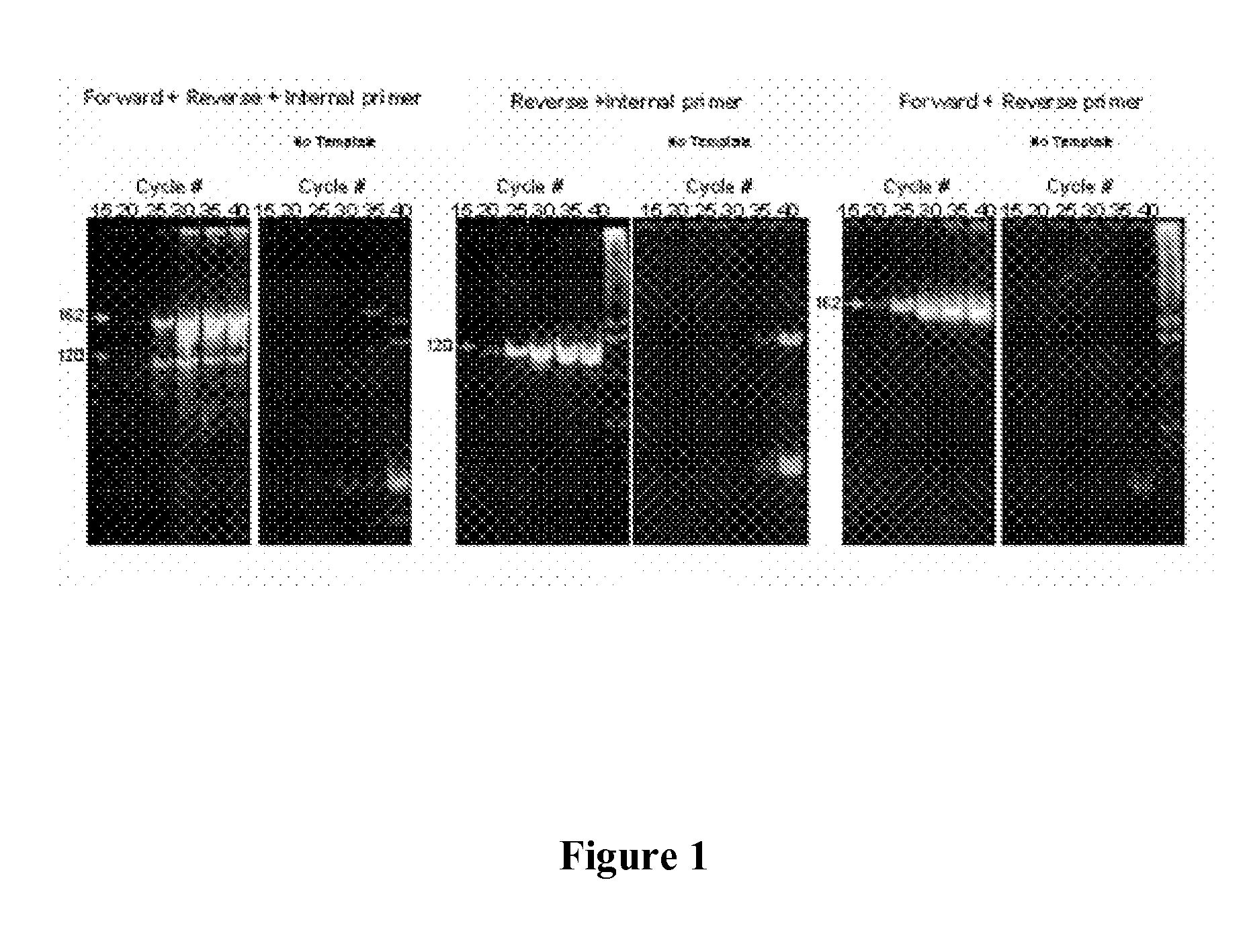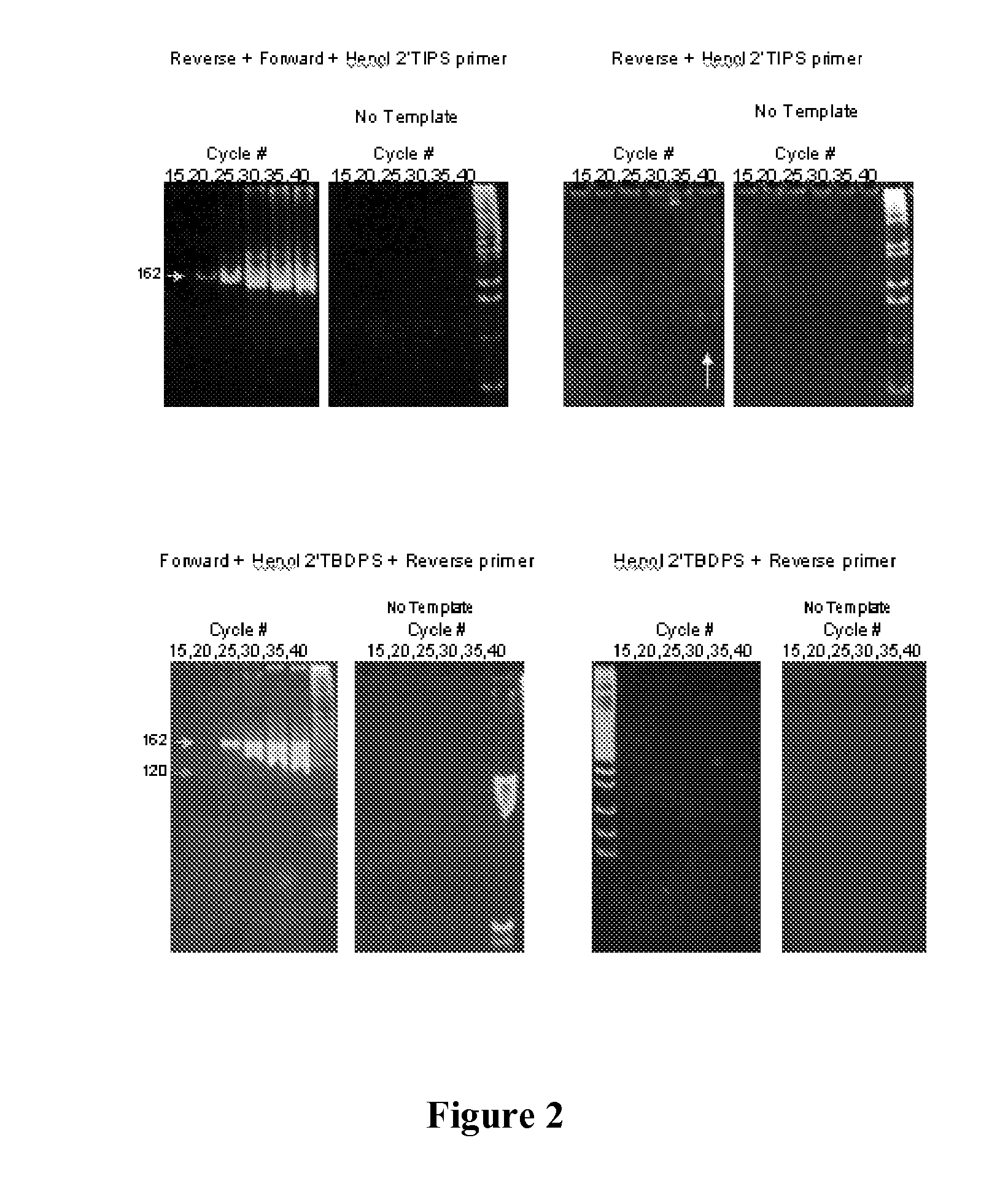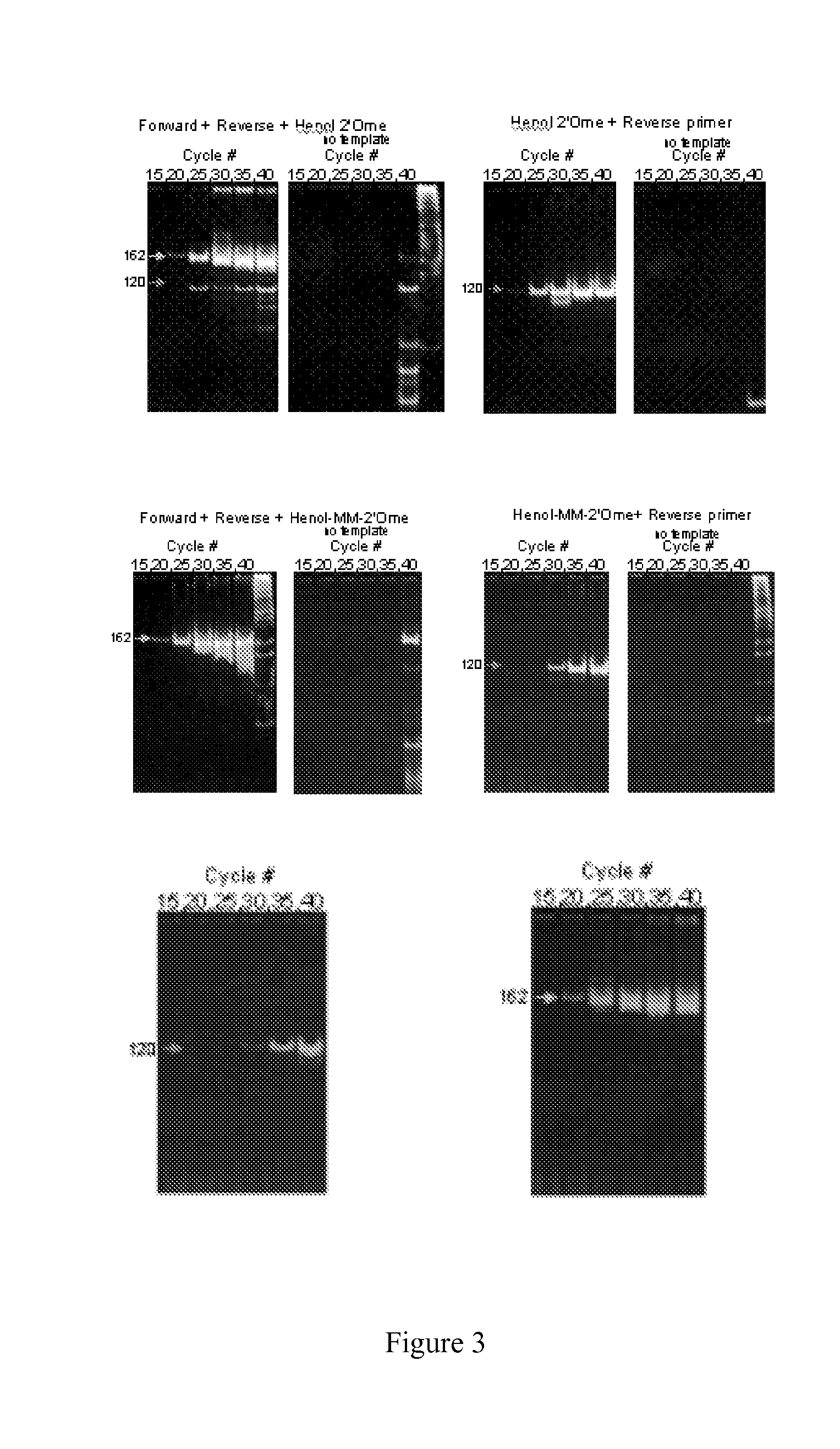Nucleic acid monomers with 2'-chemical moieties
- Summary
- Abstract
- Description
- Claims
- Application Information
AI Technical Summary
Benefits of technology
Problems solved by technology
Method used
Image
Examples
example 1
[0042] This example demonstrates the Synthesis of aminooxy activated (1-nitro-4-naphthylazo)-N,ethyl-N-ethanolaniline quencher (3).
[0043] The synthesis is as shown in Scheme 1 below. To the solution of 0.36 g (0.1 mmol) alcohol (1) (see U.S. patent application Ser. No. 10 / 987,608 for synthesis of 1), 0.17 g (0.1 mmol) N-hydroxy-phthalimide, and 0.27 g (0.1 mmol) of triphenylphosphine in 10 mL of THF was added 0.18 mL (0.1 mmol) of DEAD. After overnight stirring the reaction mixture was concentrated under diminished pressure. Flash chromatography with 1:4 EtOAc / hexanes provided 150 mg of (2). TLC: Rf 0.75 (EtOAc / hexanes-60 / 40). 1H NMR (CDCl3) δ 9.04 (d, J=8.4 Hz, 1H), 8.68 (d, J=8.4 Hz, 1H), 8.34 (d, J=8.4 Hz, 1H), 8.03 (d, J=8 Hz, 2H), 7.7-7.9 (m, 7H), 6.85 (d, J=8 Hz, 2H), 4.46 (t, J=7.5 Hz, 2H), 3.92 (t, J=7.5 Hz 2H), 3.72 (q, J=8 Hz, 2H), 1.34 (t, J=8 Hz 3H).
[0044] The solution of 10 mg (2) in 2 mL of concentrated ammonia solution in ethanol was incubated overnight at 55° C. Th...
example 2
[0045] This example demonstrates the synthesis of N4-Benzoyl-2′-O-[(3-oxobutyl)methyl]-3′-succinoyl-5′-(4,4′-Dimethoxytrityl)cytidine (8). See Scheme 2.
[0046] N4-Benzo-1-2′-O-methylthiomethyl-3′,5′-O-(1,1,3,3-tetraisoprolyldisiloxane-1,3-diyl)cytidine (4): To a solution containing 2.88 g (5.91 mmol) of N4-Benzoyl-3′,5′-O-(1,1,3,3-tetraisopropyldisiloxane-1,3-diyl)cytidine in 19 mL of DMSO, 19 mL of acetic acid and 12 mL of acetic anhydride were added. After stirring overnight, 50 mL of cold triethylamine (TEA) was added dropwise and the reaction mixture was stirred for 15 mins. 100 mL of water was added and the aqueous layer was extracted with two 100-mL portions of CH2Cl2. The organic layers were combined, dried over Na2SO4 and then solvent was removed under reduced pressure. The crude product was applied to a silica gel column; elution with a gradient of 3:7-3:2 ethyl acetate-petroleum ether provided N4-Benzoyl-2′-O-methylthiomethyl-3′,5′-O-(1,1,3,3-tetraisopropyldisiloxane-1,3-d...
example 3
[0051] This example demonstrates the synthesis of aminooxy conjugated CPG supports with (1-nitro-4-naphthylazo)-N,-ethyl-N-ethanolaniline quencher. The modified solid support (10) can be used for the synthesis of modified oligonucleotides. The synthesis is as shown in Scheme 3 below.
[0052] Synthesis of 2′-ketone modified rC CPG supports: To a slurry of long chain amino alkyl (amino-lcaa)-CPG (1.5 g) in 8 mL of acetonitrile were added 0.4 ml of pyridine, 3′-succinyl-2′-ketone-rC nucleoside (8) (0.14 g, 147 μmoles), DIC (0.157 g, 1 mmole), N-hydroxysuccinimide (6 mg, 50 μmoles) and the reaction mixture was placed on rotary shaker. After 12 hrs the resulting CPG (9) was filtered and washed with CH3CN (5×50 mL). The CPG was then treated with Ac2O:Melm:Py (10:10:80) (3×30 mL; 5 minutes each treatment). The derivatized CPG (9) washed with CH3CN (5×30 mL), CH2Cl2 (3×30 mL), and dried in vacuum overnight. DMT-loading was usually above 25-30 μmol / g.
[0053] Attachment of the chromophore to k...
PUM
| Property | Measurement | Unit |
|---|---|---|
| Composition | aaaaa | aaaaa |
| Length | aaaaa | aaaaa |
| Nucleic acid sequence | aaaaa | aaaaa |
Abstract
Description
Claims
Application Information
 Login to View More
Login to View More - R&D
- Intellectual Property
- Life Sciences
- Materials
- Tech Scout
- Unparalleled Data Quality
- Higher Quality Content
- 60% Fewer Hallucinations
Browse by: Latest US Patents, China's latest patents, Technical Efficacy Thesaurus, Application Domain, Technology Topic, Popular Technical Reports.
© 2025 PatSnap. All rights reserved.Legal|Privacy policy|Modern Slavery Act Transparency Statement|Sitemap|About US| Contact US: help@patsnap.com



